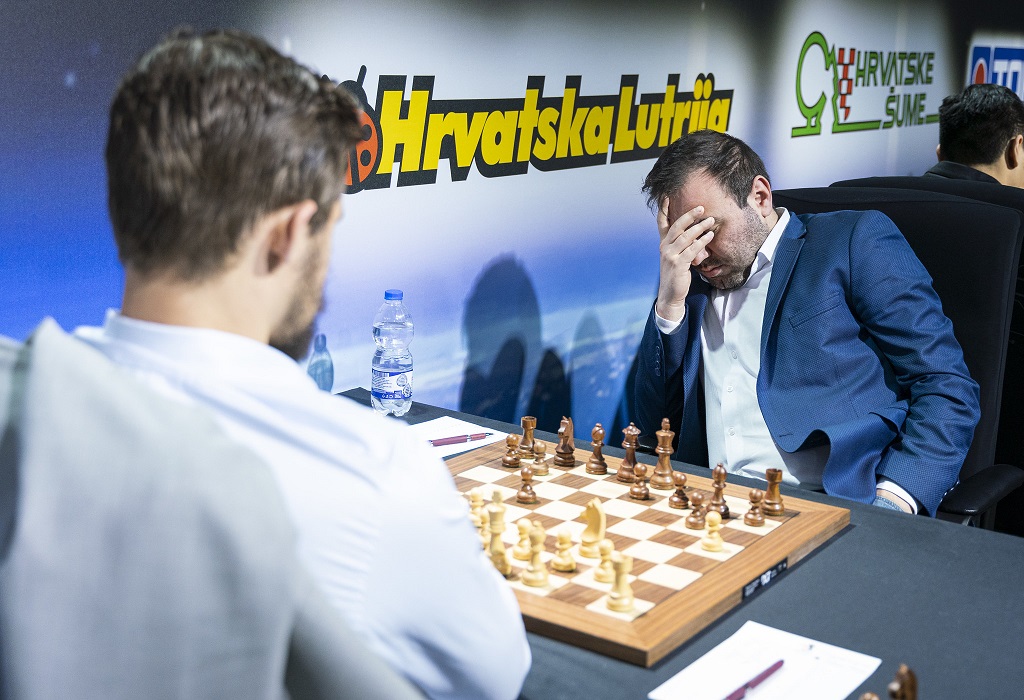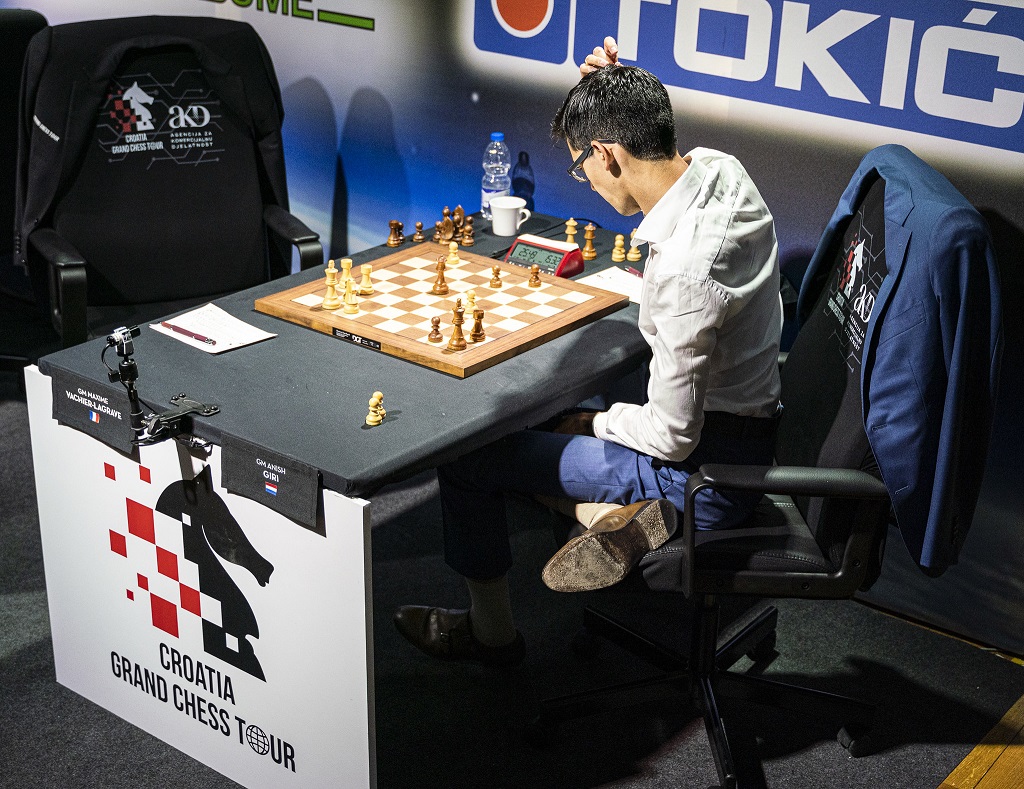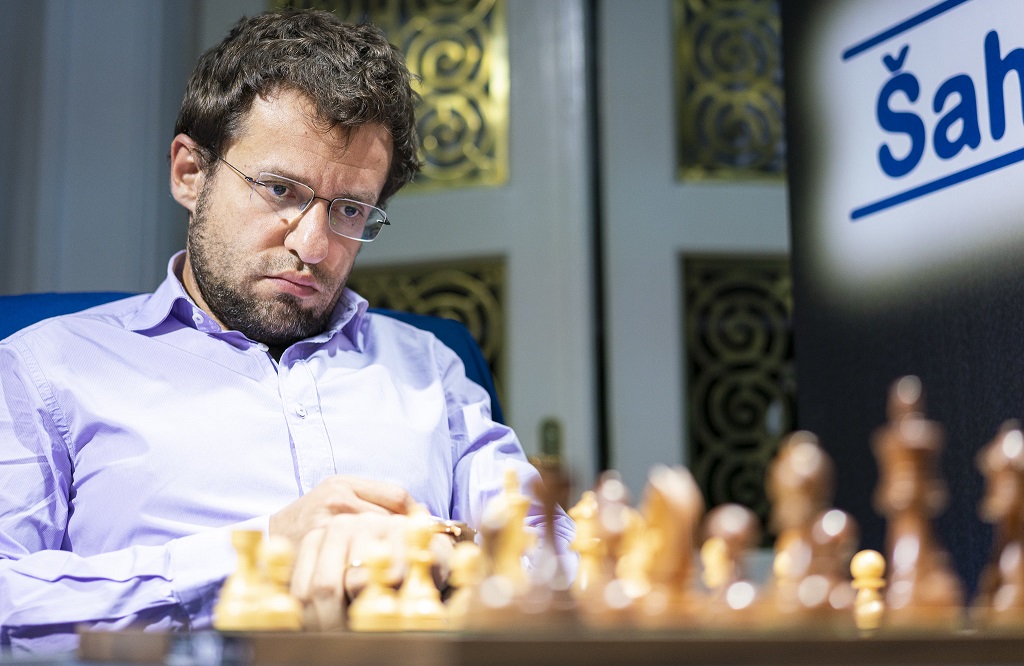


Garry Kasparov joined the commentary webcast of the Croatian leg of the GCT for a second time during round four. The living legend talked about how classical chess is not dead by any means, and that getting fighting games is only a matter of attitude. The development of the day's action only proved him right, as, despite the total absence of decisive results, the fans definitely had a good run for their money.
Shakhriyar Mamedyarov seemed to be about to go completely bust after choosing a dubious setup in the Grünfeld against Magnus Carlsen, but the world champion did not find the precise way forward and ended up needing to struggle for the draw; Anish Giri went for a sharp attack with Black against Maxime Vachier-Lagrave, but when his attempt backfired he was almost steamrolled by his rival; Fabiano Caruana and especially Sergey Karjakin also got advantageous positions with Black but could not convert them into full points.
The draws kept the standings table unchanged, with Ian Nepomniachtchi still in the sole lead.

Ian Nepomniachtchi is still the leader in Zagreb | Photo: Lennart Ootes / Grand Chess Tour
Former world champion Garry Kasparov not only talked about the death, or lack thereof, of classical chess, but he also praised Magnus Carlsen for the fighting spirit he has been showing lately, explaining to Maurice Ashley:
I think [there] is a conflict between his natural style [and his] fighting spirit. He wants to win and he knows he has to take risks. And, again, I'm grateful, I mean as I think most will be grateful to him, that instead of just trying to play for plus two or plus three he's fighting in every game. So I think he spends more time at the chessboard than any other player. So that's phenomenal, it's absolutely phenomenal.
Ashley asked Kasparov to talk about the rivalry between Carlsen and Fabiano Caruana, since he has first-hand experience in this sort of tug-of-war situation. The former world champion mentioned that "[Caruana] is still missing something", but also concluded:
If you look at other players, I think Fabi is the only one who can really give Magnus a run for his money.
The player who last beat Magnus Carlsen in a classical game is Shakhriyar Mamedyarov, who not only defeated the world champion but also finished ahead of him at last year's Biel Festival. Almost a year has passed since then, and the Norwegian has not lost any of his subsequent 72 classical encounters.
On Saturday, the number one player from Azerbaijan resolved he would not shy away from complications by choosing to lay out a Grünfeld Defence. Carlsen responded in kind by playing 5.h4, and already after the eighth move the computer assessed the position as considerably better for White:
Follow the game's moves and try your own on the diagram above
Getting some pieces to join the fray quickly was a priority for Black here, so playing 8...b6 instead of 8...♞c6 invited White to really go for it on the centre and on the kingside. The game continued 9.e4 0-0 (there is nothing better for Black, despite the presence of a white pawn on h5) 10.hxg6 hxg6 11.d4 ♝b7:
Carlsen understood it was time to play energetically and, after thinking for over twenty minutes, correctly opted for 12.♘g5. It only made sense for Black to at least take the central pawn with 12...cxd4, but now White has a strong continuation at his disposal:
Instead of 13.♕g4, planning to double on the h-file, White had 13.♗c4, as after 13...♞d7 he can go 14.♕b3, both targeting f7 and planning to transfer the queen to the h-file after an eventual cxd4. After the text, the computer thought White had given up his opening edge, but from a human point of view a huge fight was still in store.
Carlsen continued to go for the throat, but his 16.e6 was not the most precise:
Now it was Mamedyarov the one who missed a great chance — he could have gone for 16...f6, getting rid of the treacherous knight (after 17.♗d3, Black can play 17...fxg5, as White's attack is not lethal). Instead, the Azeri played 16...♛d5 and Carlsen responded with 17.exf7+.
Soon enough, White captured the exchange, but now it was his king the one that was in danger. The rest of the game was a demonstration of how challenging it can be for chess players to keep it together under enormous pressure. And, in this case, both contenders managed:

Shakhriyar Mamedyarov seems to know he is in for the long haul | Photo: Lennart Ootes / Grand Chess Tour
Photographer Lennart Ootes witnessed first-hand what had gone on at the board and twitted:
I personally love to see how nervous the players become during the game. Something that's so hard to see online is that Magnus' hands were shaking at the end of the game vs Mamedyarov.
— Lennart Ootes (@LennartOotes) 29 de junio de 2019
Chess is a game with a scientific approach, but in the end it's a human battle over the board.
To only look at the results from round four will mislead any reader who thinks this was a quiet day in Zagreb, as three other games — besides Carlsen vs Mamedyarov — also featured combative confrontations.
Leader Ian Nepomniachtchi chose what he called "literally the worst move order" in the opening against Sergey Karjakin and found himself struggling with the white pieces right from the get go. Karjakin had the half open g-file at his disposal with the white king already castled on that side of the board — he was looking for ways to break through, but failed to find the right manoeuvre on move 24:
Before pushing the h-pawn, Black needed to prevent the exchange of queens with either 24...♞e7 or 24...♞g5, covering the f5-square. Karjakin played 24...h4 immediately and Nepomniachtchi quickly took his chance to force the queen trade with 25.♕f5+. Black no longer had the strongest attacking piece on the board, and the game quickly fizzled out into a 35-move draw.

The leader Ian Nepomniachtchi giving an interview | Photo: Lennart Ootes / Grand Chess Tour
In Maxime Vachier-Lagrave vs Anish Giri, the Dutchman closed the position and went for a 19...g5 push in the middlegame, which led to a sharp fight on the kingside. There were many twists and turns, but the biggest missed chance arrived after Giri's 33rd move:
Here the computers were screaming for 34.♖xf4, but after thinking for almost ten minutes Vachier-Lagrave chose 34.♘xf4 instead. After the rook capture, the French grandmaster probably was afraid of 34...♜xh3+ 35.gxh3 ♛xh3+ 36.♔g1, thinking that some discovered check would be deadly at this point, but actually no continuation is good for Black:
In case of 36...♞e4+ White can simply go 37.♕xg8+ and retain a material edge after 37...♚xg8 38.♖xe4 — just to give an example. After Vachier-Lagrave's move, Black had some chances to create some imbalances, but there were too difficult to find with little time on the clock. Eventually, the draw was signed after 46 moves.

Anish Giri thinking hard | Photo: Lennart Ootes / Grand Chess Tour

Maxime Vachier-Lagrave did not lose the smile | Photo: Lennart Ootes / Grand Chess Tour
Fabiano Caruana advanced his kingside pawns against a tame opening approach by Levon Aronian, but could not make the most of it, as the Armenian showed resourcefulness in defence. Meanwhile, Wesley So found a perpetual check against Vishy Anand after not being able to get much with the white pieces out of the opening, and Hikaru Nakamura held Ding Liren to a 45-move draw with Black.

Armenian hero Levon Aronian | Photo: Lennart Ootes / Grand Chess Tour
Commentary by GM Yasser Seirawan, IM Jovanka Houska and GM Alejandro Ramirez